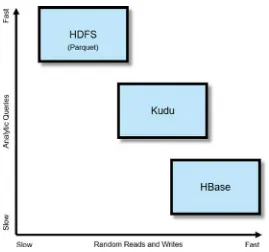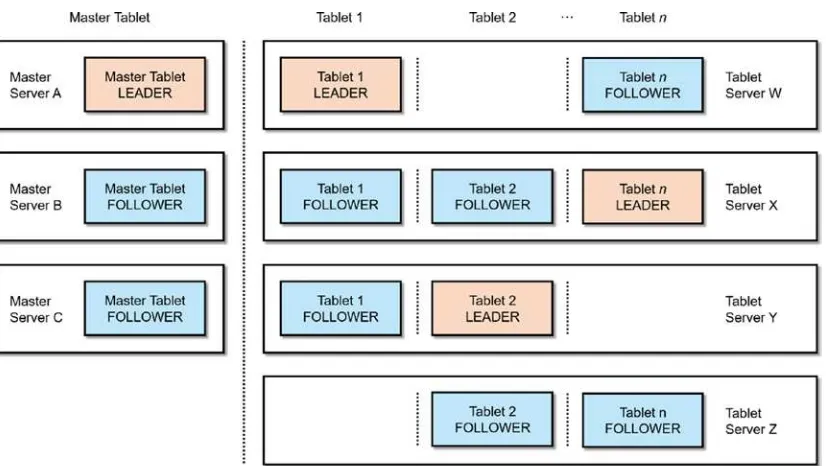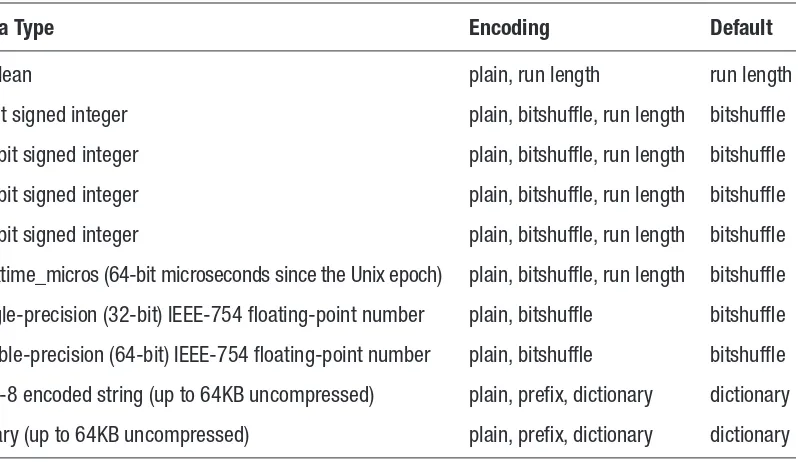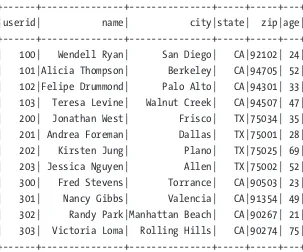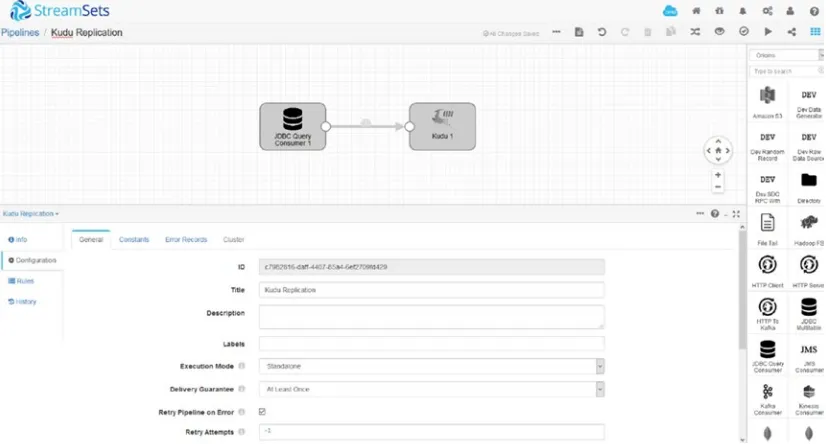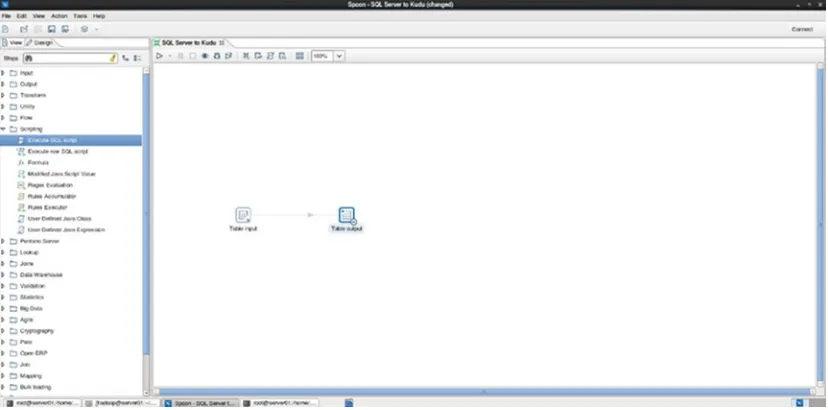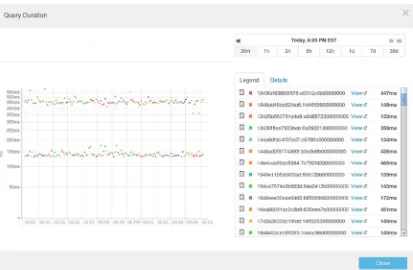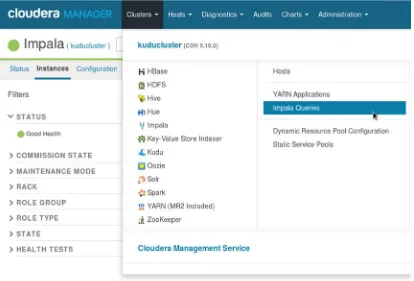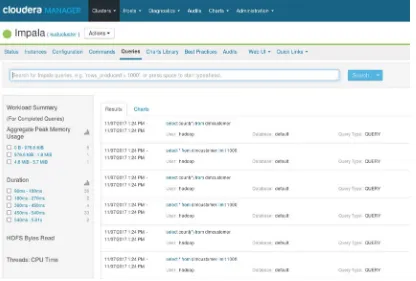Next-Generation
Big Data
A Practical Guide to Apache Kudu, Impala,
and Spark
—
Next-Generation Big Data
A Practical Guide to Apache Kudu,
Impala, and Spark
ISBN-13 (pbk): 978-1-4842-3146-3 ISBN-13 (electronic): 978-1-4842-3147-0 https://doi.org/10.1007/978-1-4842-3147-0
Library of Congress Control Number: 2018947173
Copyright © 2018 by Butch Quinto
This work is subject to copyright. All rights are reserved by the Publisher, whether the whole or part of the material is concerned, specifically the rights of translation, reprinting, reuse of illustrations, recitation, broadcasting, reproduction on microfilms or in any other physical way, and transmission or information storage and retrieval, electronic adaptation, computer software, or by similar or dissimilar methodology now known or hereafter developed.
Trademarked names, logos, and images may appear in this book. Rather than use a trademark symbol with every occurrence of a trademarked name, logo, or image we use the names, logos, and images only in an editorial fashion and to the benefit of the trademark owner, with no intention of infringement of the trademark.
The use in this publication of trade names, trademarks, service marks, and similar terms, even if they are not identified as such, is not to be taken as an expression of opinion as to whether or not they are subject to proprietary rights.
While the advice and information in this book are believed to be true and accurate at the date of publication, neither the authors nor the editors nor the publisher can accept any legal responsibility for any errors or omissions that may be made. The publisher makes no warranty, express or implied, with respect to the material contained herein.
Managing Director, Apress Media LLC: Welmoed Spahr Acquisitions Editor: Susan McDermott
Development Editor: Laura Berendson Coordinating Editor: Rita Fernando Cover designed by eStudioCalamar
Cover image designed by Freepik (www.freepik.com)
Distributed to the book trade worldwide by Springer Science+Business Media New York, 233 Spring Street, 6th Floor, New York, NY 10013. Phone 1-800-SPRINGER, fax (201) 348-4505, e-mail orders-ny@ springer-sbm.com, or visit www.springeronline.com. Apress Media, LLC is a California LLC and the sole member (owner) is Springer Science + Business Media Finance Inc (SSBM Finance Inc). SSBM Finance Inc is a Delaware corporation.
For information on translations, please e-mail [email protected], or visit http://www.apress.com/ rights-permissions.
Apress titles may be purchased in bulk for academic, corporate, or promotional use. eBook versions and licenses are also available for most titles. For more information, reference our Print and eBook Bulk Sales web page at http://www.apress.com/bulk-sales.
Any source code or other supplementary material referenced by the author in this book is available to readers on GitHub via the book’s product page, located at www.apress.com/9781484231463. For more detailed information, please visit http://www.apress.com/source-code.
Printed on acid-free paper Butch Quinto
Table of Contents
Chapter 1: Next-Generation Big Data ������������������������������������������������������������������������ 1
About This Book ... 2
Apache Spark ... 2
Apache Impala ... 3
Apache Kudu ... 3
Navigating This Book ... 3
Summary... 5
Chapter 2: Introduction to Kudu ������������������������������������������������������������������������������� 7
Kudu Is for Structured Data ... 9Use Cases ... 9
Relational Data Management and Analytics ... 10
Internet of Things (IoT) and Time Series ... 11
Feature Store for Machine Learning Platforms ... 12
Key Concepts ... 12
Architecture ... 13
Multi-Version Concurrency Control (MVCC) ... 14
Impala and Kudu ... 15
Primary Key ... 15
Data Types ... 16
Spark and Kudu ... 19
Kudu Context ... 19
Kudu C++, Java, and Python Client APIs ... 24
Kudu Java Client API ... 24
Kudu Python Client API ... 27
Kudu C++ Client API ... 29
Backup and Recovery ... 34
Backup via CTAS ... 34
Copy the Parquet Files to Another Cluster or S3 ... 35
Export Results via impala-shell to Local Directory, NFS, or SAN Volume... 36
Export Results Using the Kudu Client API ... 36
Export Results with Spark ... 38
Replication with Spark and Kudu Data Source API ... 38
Real-Time Replication with StreamSets ... 40
Replicating Data Using ETL Tools Such as Talend, Pentaho, and CDAP ... 41
Python and Impala ... 43
Impyla ... 43
pyodbc ... 44
SQLAlchemy ... 44
High Availability Options ... 44
Active-Active Dual Ingest with Kafka and Spark Streaming ... 45
Active-Active Kafka Replication with MirrorMaker ... 45
Active-Active Dual Ingest with Kafka and StreamSets ... 46
Active-Active Dual Ingest with StreamSets ... 47
Administration and Monitoring... 47
Cloudera Manager Kudu Service ... 47
Kudu Master Web UI ... 47
Kudu Tablet Server Web UI ... 48
Kudu Metrics ... 48
Kudu Command-Line Tools ... 48
Security ... 52
Summary... 53
References ... 53
Chapter 3: Introduction to Impala �������������������������������������������������������������������������� 57
Architecture ... 57Impala Server Components ... 58
Impala SQL ... 63
Complex Types in Impala ... 76
Querying Struct Fields ... 77
Querying Deeply Nested Collections... 78
Querying Using ANSI-92 SQL Joins with Nested Collections ... 79
Impala Shell ... 79
Performance Tuning and Monitoring ... 84
Explain ... 85
Summary ... 85
Profile ... 86
Cloudera Manager ... 87
Impala Performance Recommendations ... 93
Workload and Resource Management ... 95
Admission Control ... 95
Hadoop User Experience ... 96
Impala in the Enterprise ... 98
Summary... 98
Chapter 4: High Performance Data Analysis with Impala and Kudu �������������������� 101
Primary Key ... 101
Data Types ... 102
Internal and External Impala Tables ... 103
Internal Tables ... 103
Using JDBC with Apache Impala and Kudu ... 109
Federation with SQL Server Linked Server and Oracle Gateway ... 110
Summary... 111
References ... 111
Introduction to the Spark-Shell ... 117
SparkSession ... 118
Accumulator ... 119
Broadcast Variables ... 119
RDD ... 119
Spark SQL, Dataset, and DataFrames API ... 127
Spark Data Sources ... 129
CSV ... 129
XML... 130
JSON ... 131
Relational Databases Using JDBC ... 132
Parquet ... 136
Spark MLlib (DataFrame-Based API) ... 145
Monitoring and Configuration ... 153
Cloudera Manager ... 153
Spark Web UI ... 154
Summary... 157
References ... 157
Chapter 6: High Performance Data Processing with Spark and Kudu ������������������ 159
Spark and Kudu ... 159Spark 1.6.x ... 159
Spark 2.x ... 160
Kudu Context ... 160
Inserting Data ... 161
Updating a Kudu Table ... 162
Upserting Data ... 163
Deleting Data ... 164
Selecting Data ... 165
Creating a Kudu Table ... 165
Inserting CSV into Kudu ... 166
Inserting CSV into Kudu Using the spark-csv Package ... 166
Insert CSV into Kudu by Programmatically Specifying the Schema ... 167
Inserting XML into Kudu Using the spark-xml Package ... 168
Inserting JSON into Kudu ... 171
Inserting from MySQL into Kudu ... 173
Inserting from SQL Server into Kudu ... 178
Inserting from HBase into Kudu ... 188
Inserting from Solr into Kudu ... 194
Insert from Amazon S3 into Kudu ... 195
Inserting from Kudu into MySQL ... 196
Inserting from Kudu into SQL Server ... 198
Inserting from Kudu into Oracle ... 201
Inserting Rows from Kudu to Parquet... 208
Insert SQL Server and Oracle DataFrames into Kudu ... 210
Insert Kudu and SQL Server DataFrames into Oracle ... 214
Spark Streaming and Kudu... 218
Kudu as a Feature Store for Spark MLlib ... 222
Summary... 228
References ... 228
Chapter 7: Batch and Real-Time Data Ingestion and Processing ������������������������� 231
StreamSets Data Collector ... 231Pipelines ... 232
Origins ... 232
Processors ... 232
Destinations ... 232
Executors ... 233
Data Collector Console ... 233
Deployment Options ... 237
Using StreamSets Data Collector ... 237
Ingesting XML to Kudu... 238
Configure Pipeline ... 242
Configure the Directory Origin ... 243
Configure the XML Parser Processor ... 246
Validate and Preview Pipeline ... 247
Start the Pipeline ... 251
Stream Selector ... 255
Expression Evaluator ... 265
Using the JavaScript Evaluator ... 274
Ingesting into Multiple Kudu Clusters ... 281
REST API ... 286
Event Framework ... 289
Other Next-Generation Big Data Integration Tools ... 290
Data Ingestion with Kudu ... 290
Pentaho Data Integration ... 306
Ingest CSV into HDFS and Kudu ... 306
Data Ingestion to Kudu with Transformation ... 328
SQL Server to Kudu ... 331
Talend Open Studio ... 341
Ingesting CSV Files to Kudu ... 342
SQL Server to Kudu ... 349
Data Transformation ... 355
Other Big Data Integration Players ... 359
Informatica ... 360
Microsoft SQL Server Integration Services ... 360
Oracle Data Integrator for Big Data ... 360
IBM InfoSphere DataStage ... 361
Syncsort ... 361
Apache NIFI ... 361
Data Ingestion with Native Tools ... 362
Kudu and Spark ... 362
Sqoop ... 369
Kudu Client API ... 370
MapReduce and Kudu ... 370
Summary... 371
References ... 371
Chapter 8: Big Data Warehousing ������������������������������������������������������������������������� 375
Enterprise Data Warehousing in the Era of Big Data ... 376Structured Data Still Reigns Supreme ... 376
EDW Modernization ... 376
ETL Offloading ... 378
Analytics Offloading and Active Archiving ... 379
Replatforming the Enterprise Data Warehouse ... 380
Big Data Warehousing 101 ... 381
Dimensional Modeling ... 381
Big Data Warehousing with Impala and Kudu ... 384
Summary... 405
References ... 405
Chapter 9: Big Data Visualization and Data Wrangling ����������������������������������������� 407
Big Data Visualization ... 407SAS Visual Analytics ... 408
Zoomdata ... 408
Self-Service BI and Analytics for Big Data ... 408
Real-Time Data Visualization ... 409
Architecture ... 409
Deep Integration with Apache Spark ... 410
Zoomdata Fusion ... 411
Data Sharpening ... 411
Support for Multiple Data Sources ... 412
Real-Time IoT with StreamSets, Kudu, and Zoomdata ... 426
Create the Kudu Table... 426
Data Wrangling ... 445
Chapter 10: Distributed In-Memory Big Data Computing ������������������������������������� 477
Architecture ... 478Why Use Alluxio? ... 479
Significantly Improve Big Data Processing Performance and Scalability ... 480
Provides High Availability and Persistence in Case of Application
Termination or Failure ... 482
Optimize Overall Memory Usage and Minimize Garbage Collection ... 486
Reduce Hardware Requirements ... 486
Alluxio Components ... 487
Installation ... 487
Apache Spark and Alluxio ... 489
Administering Alluxio ... 489
Chapter 11: Big Data Governance and Management �������������������������������������������� 495
Data Governance for Big Data ... 496Cloudera Navigator ... 496
Metadata Management ... 498
Data Classification ... 499
Data Lineage and Impact Analysis... 500
Auditing and Access Control ... 500
Policy Enforcement and Data Lifecycle Automation ... 501
Cloudera Navigator REST API ... 502
Cloudera Navigator Encrypt ... 502
Other Data Governance Tools ... 503
Apache Atlas ... 503
Informatica Metadata Manager and Enterprise Data Catalog ... 503
Collibra ... 503
Waterline Data ... 504
Smartlogic ... 504
Chapter 12: Big Data in the Cloud ������������������������������������������������������������������������� 507
Amazon Web Services (AWS) ... 507
Microsoft Azure Services ... 507
Google Cloud Platform (GCP) ... 508
Cloudera Enterprise in the Cloud ... 509
Hybrid and Multi-Cloud ... 509
Transient Clusters ... 510
Persistent Clusters ... 510
Cloudera Director ... 511
Summary... 532
References ... 532
Chapter 13: Big Data Case Studies ����������������������������������������������������������������������� 537
Navistar ... 537Use Cases ... 537
Solution ... 538
Technology and Applications ... 538
Outcome ... 539
Cerner ... 539
Use Cases ... 539
Solution ... 539
Technology and Applications ... 540
Outcome ... 541
British Telecom ... 541
Use Cases ... 541
Solution ... 542
Technology and Applications ... 542
Outcome ... 542
Shopzilla (Connexity) ... 543
Use Cases ... 543
Solution ... 543
Technology and Applications ... 544
Thomson Reuters ... 544
Use Cases ... 545
Solution ... 545
Technology and Applications ... 545
Outcome ... 546
Mastercard ... 546
Use Cases ... 546
Solution ... 547
Technology and Applications ... 547
Outcome ... 547
Summary... 547
References ... 547
About the Author
Butch Quinto is Chief Data Officer at Lykuid, Inc. an advanced analytics company that provides an AI-powered infrastructure monitoring platform. As Chief Data Officer, Butch serves as the head of AI and data engineering, leading product innovation, strategy, research and development. Butch was previously Director of Analytics at Deloitte where he led strategy, solutions development and delivery, technology innovation, business development, vendor alliance and venture capital due diligence. While at Deloitte, Butch founded and developed several key big data, IoT and artificial intelligence applications including Deloitte’s IoT Framework, Smart City Platform and Geo-Distributed
Telematics Platform. Butch was also the co-founder and lead lecturer of Deloitte’s national data science and big data training programs.
About the Technical Reviewer
Acknowledgments
Introduction
This book serves as a practical guide on how to utilize big data to store, process, and analyze structured data, focusing on three of the most popular Apache projects in the Hadoop ecosystem: Apache Spark, Apache Impala, and Apache Kudu (incubating). Together, these three Apache projects can rival most commercial data warehouse platforms in terms of performance and scalability at a fraction of the cost. Most next- generation big data and data science use cases are driven by structured data, and this book will serve as your guide.
I approach this book from an enterprise point of view. I cover not just the main technologies, I also examine advanced enterprise topics. This includes data governance and management, big data in the cloud, in-memory computing, backup and recovery, high availability, Internet of Things (IoT), data wrangling, and real-time data ingestion and visualization. I also discuss integration with popular third-party commercial applications and platforms from popular software vendors such as Oracle, Microsoft, SAS, Informatica, StreamSets, Zoomdata, Talend, Pentaho, Trifacta, Alteryx, Datameer, and Cask. For most of us, integrating big data with existing business intelligence and data warehouse infrastructure is a fact of life. Last but definitely not the least, I discuss several interesting big data case studies from some of the most innovative companies in the world including Navistar, Cerner, British Telecom, Shopzilla (Connexity), Thomson Reuters, and Mastercard.
1 © Butch Quinto 2018
Next-Generation Big Data
Despite all the excitement around big data, the large majority of mission-critical data is still stored in relational database management systems. This fact is supported by recent studies online and confirmed by my own professional experience working on numerous big data and business intelligence projects. Despite widespread interest in unstructured and semi-structured data, structured data still represents a significant percentage of data under management for most organizations, from the largest corporations and government agencies to small businesses and technology start-ups. Use cases that deals with unstructured and semi-structured data, while valuable and interesting, are few and far between. Unless you work for a company that does a lot of unstructured data processing such as Google, Facebook, or Apple, you are most likely working with structured data.
About This Book
This book is for business intelligence and data warehouse professionals who are interested in gaining practical and real-world insight into next-generation big data processing and analytics using Apache Kudu, Apache Impala, and Apache Spark. Experienced big data professionals who would like to learn more about Kudu and other advanced enterprise topics such as real-time data ingestion and complex event processing, Internet of Things (IoT), distributed in-memory computing, big data in the cloud, big data governance and management, real-time data visualization, data wrangling, data warehouse optimization, and big data warehousing will also benefit from this book.
I assume readers will have basic knowledge of the various components of Hadoop. Some knowledge of relational database management systems, business intelligence, and data warehousing is also helpful. Some programming experience is required if you want to run the sample code provided. I focus on three main Hadoop components: Apache Spark, Apache Impala, and Apache Kudu.
Apache Spark
Apache Spark is the next-generation data processing framework with advanced in-memory capabilities and a directed acyclic graph (DAG) engine. It can handle interactive, real-time, and batch workloads with built-in machine learning, graph processing, streaming, and SQL support. Spark was developed to address the
Apache Impala
Apache Impala is a massively parallel processing (MPP) SQL engine designed to run on Hadoop platforms. The project was started by Cloudera and eventually donated to the Apache Software Foundation. Impala rivals traditional data warehouse platforms in terms of performance and scalability and was designed for business intelligence and OLAP workloads. Impala is compatible with some of the most popular BI and data visualization tools such as Tableau, Qlik, Zoomdata, Power BI, and MicroStrategy to mention a few. I cover Apache Impala in Chapter 3 and Impala and Kudu integration in Chapter 4.
Apache Kudu
Apache Kudu is a new mutable columnar storage engine designed to handle fast data inserts and updates and efficient table scans, enabling real-time data processing and analytic workloads. When used together with Impala, Kudu is ideal for Big Data Warehousing, EDW modernization, Internet of Things (IoT), real-time visualization, complex event processing, and feature store for machine learning. As a storage engine, Kudu’s performance and scalability rivals other columnar storage format such as Parquet and ORC. It also performs significantly faster than Apache Phoenix with HBase. I discuss Kudu in Chapter 2.
Navigating This Book
Chapter 1 – Next-Generation Big Data provides a brief introduction about the contents of this book.
Chapter 2 – Introduction to Kudu provides an introduction to Apache Kudu, starting with a discussion of Kudu’s architecture. I talk about various topics such as how to access Kudu from Impala, Spark, and Python, C++ and Java using the client API. I provide details on how to administer, configure, and monitor Kudu, including backup and recovery and high availability options for Kudu. I also discuss Kudu’s strength and limitations, including practical workarounds and advice.
Chapter 3 – Introduction to Impala provides an introduction to Apache Impala. I discuss Impala’s technical architecture and capabilities with easy-to-follow examples. I cover details on how to perform system administration, monitoring, and performance tuning.
Chapter 4 – High Performance Data Analysis with Impala and Kudu covers Impala and Kudu integration with practical examples and real-world advice on how to leverage both components to deliver a high performance environment for data analysis. I discuss Impala and Kudu’s strength and limitations, including practical workarounds and advice.
Chapter 5 – Introduction to Spark provides an introduction to Apache Spark. I cover Spark’s architecture and capabilities, with practical explanations and easy-to- follow examples to help you get started with Spark development right away.
Chapter 6 – High Performance Data Processing with Spark and Kudu covers Spark and Kudu integration with practical examples and real-world advice on how to use both components for large-scale data processing and analysis.
Chapter 7 – Batch and Real-Time Data Ingestion and Processing covers batch and real-time data ingestion and processing using native and third-party commercial tools such as Flume, Kafka, Spark Streaming, StreamSets, Talend, Pentaho, and Cask. I provide step-by-step examples on how to implement complex event processing and the Internet of Things (IoT).
Chapter 9 – Big Data Visualization and Data Wrangling discusses real-time data visualization and wrangling tools designed for extremely large data sets with easy-to- follow examples and advice.
Chapter 10 – Distributed In-Memory Big Data Computing covers Alluxio, previously known as Tachyon. I discuss its architecture and capabilities. I also discuss Apache Ignite and Geode.
Chapter 11 – Big Data Governance and Management covers big data governance and management. I discuss data lineage, metadata management, auditing, and policy enforcement using Cloudera Navigator. I also examine other popular data governance and metadata management applications.
Chapter 12 – Big Data in the Cloud covers deploying and using Apache Kudu, Spark, and Impala in the cloud with step-by-step instructions and examples.
Chapter 13 – Big Data Case Studies provides six innovative big data case studies, including details about challenges, implementation details, solutions, and outcomes. The case studies are provided with permission from Cloudera.
Summary
Introduction to Kudu
Kudu is an Apache-licensed open source columnar storage engine built for the Apache Hadoop platform. It supports fast sequential and random reads and writes, enabling real-time stream processing and analytic workloads.i It integrates with Impala, allowing
you to insert, delete, update, upsert, and retrieve data using SQL. Kudu also integrates with Spark (and MapReduce) for fast and scalable data processing and analytics. Like other projects in the Apache Hadoop ecosystem, Kudu runs on commodity hardware and was designed to be highly scalable and highly available.
The Apache Kudu project was founded in 2012 by Todd Lipcon, a software engineer at Cloudera and PMC member and committer on the Hadoop, HBase, and Thrift projects.ii Kudu was developed to address the limitations of HDFS and HBase while
combining both of its strengths. While HDFS supports fast analytics and large table scans, files stored in HDFS are immutable and can only be appended to after they are created.iii HBase makes it possible to update and randomly access data, but it’s slow for
Prior to Kudu, some data engineers used a data processing architecture called the Lambda architecture to work around the limitations of HDFS and HBase. The Lambda architecture works by having a speed and batch layer (and technically, there’s also a serving layer). Transaction data goes to the speed layer (usually HBase) where users get immediate access to the latest data. Data from the speed layer is copied at regular intervals (hourly or daily) to the batch layer (usually HDFS) in Parquet format, to be utilized for reporting and analytics. As you can see in Figure 2-2, data is copied twice and the data pipline is more complicated than necessary with the Lambda architecture. This is somewhat similar to a typical enterprise data warehouse environment with OLTP databases representing the “speed layer” and the data warehouse acting as the “batch layer.”
Kudu makes the Lambda architecture obsolete due to its ability to simultaneously handle random reads and writes and analytic workloads. With Kudu, there is no data duplication and the data pipeline is considerably simpler, as shown in Figure 2-3.
Figure 2-2.
Lambda Architecture
Figure 2-3.
Modern data ingest pipeline using Kudu
Kudu Is for Structured Data
Kudu was designed to store structured data similar to relational databases. In fact, Kudu (when used with Impala) is often used for relational data management and analytics. Kudu rivals commercial data warehouse platforms in terms of capabilities, performance, and scalability. We’ll discuss Impala and Kudu integration later in the chapter and more thoroughly in Chapter 4.
Use Cases
HDFS was designed to store all types of data: structured, semi-structured, and unstructured. If you need to store data in a highly scalable file system, HDFS is a great option. As mentioned earlier, HDFS (using Parquet) is still faster in some cases than Kudu when it comes to running analytic workloads. For more on HDFS, see the HDFS online documentation.
As discussed earlier, Kudu excels at storing structured data. It doesn’t have an SQL interface, therefore you need to pair Kudu with Impala. Data that you would normally think of storing in a relational or time series database can most likely be stored in Kudu as well. Below are some use cases where Kudu can be utilized.iv
Relational Data Management and Analytics
Kudu (when used with Impala) exhibits most of the characteristics of a relational database. It stores data in rows and columns and organizes them in databases and tables. Impala provides a highly scalable MPP SQL engine and allows you to interact with Kudu tables using ANSI SQL commands just as you would with a relational database. Relational database use cases can be classified into two main categories, online transactional processing (OLTP) and decision support systems (DSS) or as commonly referred to in modern nomenclature, data warehousing. Kudu was not designed for OLTP, but it can be used for data warehousing and other enterprise data warehouse (EDW) modernization use cases.
Data Warehousing
Kudu can be used for dimensional modeling – the basis of modern data warehousing and online analytic processing (OLAP). Kudu lacks foreign key constraints,
ETL Offloading
ETL offloading is one of the many EDW optimization use cases that you can use Kudu for. Critical reports are unavailable to the entire organization due to ETL processes running far beyond its processing window and pass into the business hours. By offloading time-consuming ETL processing to an inexpensive Kudu cluster, ETL jobs can finish before business hours, making critical reports and analytics available to business users when they need it. I discuss ETL offloading using Impala and Kudu in Chapter 8.
Analytics Offloading and Active Archiving
Impala is an extremely fast and scalable MPP SQL engine. You can reduce the load on your enterprise data warehouse by redirecting some of your ad hoc queries and reports to Impala and Kudu. Instead of spending millions of dollars upgrading your data warehouse, analytics offloading and active archiving is the smarter and more cost-effective way to optimize your EDW environment. I discuss analytics offloading and active archiving using Impala and Kudu in Chapter 8.
Data Consolidation
It’s not unusual for large organizations to have hundreds or thousands of legacy databases scattered across its enterprise, paying millions of dollars in licensing, administration and infrastructure cost. By consolidating these databases into a single Kudu cluster and using Impala to provide SQL access, you can significantly reduce cost while improving performance and scalability. I discuss data consolidation using Impala and Kudu in Chapter 8.
Internet of Things (IoT) and Time Series
Kudu is perfect for IoT and time series applications where real-time data ingestion, visualization, and complex event processing of sensor data is critical. Several large companies and government agencies such as Xiaomi, JD.com,v and Australia
Department of Defensevi are successfully using Kudu for IoT use cases. I discuss IoT,
Feature Store for Machine Learning Platforms
Data science teams usually create a centralized feature store where they can publish and share highly selected sets of authoritative features with other teams for creating machine learning models. Creating and maintaining feature stores using immutable data formats such as ORC and Parquet is time consuming, cumbersome, and requires too much unnecessary hard work, especially for large data sets. Using Kudu as a fast and highly scalable mutable feature store, data scientists and engineers can easily update and add features using familiar SQL statements. The ability to update feature stores in seconds or minutes is critical in an Agile environment where data scientists are constantly iterating in building, testing, and improving the accuracy of their predictive models. In Chapter 6, we use Kudu as a feature store for building a predictive machine learning model using Spark MLlib.
Note Kudu allows up to a maximum of 300 columns per table. hBase is a more
appropriate storage engine if you need to store more than 300 features. hBase
tables can contain thousands or millions of columns. the downside in using hBase
is that it is not as efficient in handling full table scans compared to Kudu. there
is discussion within the apache Kudu community to address the 300-column
limitation in future versions of Kudu.
Strictly speaking, you can bypass Kudu’s 300-column limit by setting an unsafe flag. For example, if you need the ability to create a Kudu table with 1000 columns, you can start the Kudu master with the following flags: --unlock-unsafe-flags --max-num-columns=1000. This has not been thoroughly tested by the Kudu development team and is therefore not recommended for production use.
Key Concepts
Kudu introduces a few concepts that describe different parts of its architecture.
Table A table is where data is stored in Kudu. Every Kudu table has a primary key and is divided into segments called tablets.
Tablet A tablet, or partition, is a segment of a table.
Master A master keeps track of all cluster metadata and coordinates metadata operations.
Catalog Table Central storage for all of cluster metadata. The catalog table stores information about the location of tables and tablets, their current state, and number of replicas. The catalog table is stored in the master.
Architecture
Similar to the design of other Hadoop components such as HDFS and HBase (and their Google counterparts, BigTable and GFS), Kudu has a master-slave architecture. As shown in Figure 2-4, Kudu comprises one or more Master servers responsible for cluster coordination and metadata management. Kudu also has one or more tablet servers, storing data and serving them to client applications.vii For a tablet, there can only be one
acting master, the leader, at any given time. If the leader becomes unavailable, another master is elected to become the new leader. Similar to the master, one tablet server acts as a leader, and the rest are followers. All write request go to the leader, while read requests go to the leader or replicas. Data stored in Kudu is replicated using the Raft Consensus Algorithm, guaranteeing the availability of data will survive the loss of some of the replica as long as the majority of the total number of replicas is still available. Whenever possible, Kudu replicates logical operations instead of actual physical data, limiting the amount of data movement across the cluster.
Multi-Version Concurrency Control (MVCC)
Most modern databases use some form of concurrency control to ensure read consistency instead of traditional locking mechanisms. Oracle has a multi-version consistency model since version 6.0.x Oracle uses data maintained in the rollback
segments to provide read consistency. The rollback segments contain the previous data that have been modified by uncommitted or recently committed transactions.xi MemSQL
and SAP HANA manages concurrency using MVCC as well. Originally, SQL Server only supported a pessimistic concurrency model, using locking to enforce concurrency. As a result, readers block writers and writers block readers. The likelihood of blocking problems and lock contention increase as the number of concurrent users and
operations rise, leading to performance and scalability issues. Things became so bad in SQL Server-land that developers and DBAs were forced to use the NOLOCK hint in their queries or set the READ UNCOMITTED isolation level, tolerating dirty reads in exchange for a minor performance boost. Starting in SQL Server 2005, Microsoft introduced its own version of multi-version concurrency control known as row-level versioning.xii
SQL Server doesn’t have the equivalent of rollback segments so it uses tempdb to store previously committed data. Teradata does not have multi-version consistency model and relies on transactions and locks to enforce concurrency control.xiii
Similar to Oracle, MemSQL, and SAP HANA, Kudu uses multi-version concurrency control to ensure read consistency.xiv Readers don’t block writers and writers don’t block
readers. Kudu’s optimistic concurrency model means that operations are not required to acquire locks during large full table scans, considerably improving query performance and scalability.
Impala and Kudu
Impala is the default MPP SQL engine for Kudu. Impala allows you to interact with Kudu using SQL. If you have experience with traditional relational databases where the SQL and storage engines are tightly integrated, you might find it unusual that Kudu and Impala are decoupled from each other. Impala was designed to work with other storage engines such as HDFS, HBase, and S3, not just Kudu. There’s also work underway to integrate other SQL engines such as Apache Drill (DRILL-4241) and Hive (HIVE-12971) with Kudu. Decoupling storage, SQL, and processing engines are common practices in the open source community.
The Impala-Kudu integration works great but there is still work to be done. While it matches or exceeds traditional data warehouse platforms in terms of performance and scalability, Impala-Kudu lacks some of the enterprise features found in most traditional data warehouse platforms. We discuss some of these limitations later in the chapter.
Primary Key
Data Types
Like other relational databases, Kudu supports various data types (Table 2-1).
Table 2-1.
List of Data Types, with Available and Default Encoding
Data Type Encoding Default
boolean plain, run length run length
8-bit signed integer plain, bitshuffle, run length bitshuffle
16-bit signed integer plain, bitshuffle, run length bitshuffle
32-bit signed integer plain, bitshuffle, run length bitshuffle
64-bit signed integer plain, bitshuffle, run length bitshuffle
unixtime_micros (64-bit microseconds since the unix epoch) plain, bitshuffle, run length bitshuffle
single-precision (32-bit) Ieee-754 floating-point number plain, bitshuffle bitshuffle
double-precision (64-bit) Ieee-754 floating-point number plain, bitshuffle bitshuffle
utF-8 encoded string (up to 64KB uncompressed) plain, prefix, dictionary dictionary
binary (up to 64KB uncompressed) plain, prefix, dictionary dictionary
You may notice that Kudu currently does not support the decimal data type. This is a key limitation in Kudu. The float and double data types only store a very close approximation of the value instead of the exact value as defined in the IEEE 754 specification.xv Because of this behaviour, float and double are not appropriate for
storing financial data. At the time of writing, support for decimal data type is still under development (Apache Kudu 1.5 / CDH 5.13). Decimal support is coming in Kudu 1.7. Check KUDU-721 for more details. There are various workarounds available. You can store financial data as string then use Impala to cast the value to decimal every time you need to read the data. Since Parquet supports decimals, another workaround would be to use Parquet for your fact tables and Kudu for dimension tables.
Note In earlier versions of Kudu, date and time are represented as a BIGInt. You
can use the tIMeStaMp data type in Kudu tables starting in Impala 2.9/Cdh 5.12.
however, there are several things to keep in mind. Kudu represents date and time
columns using 64-bit values, while Impala represents date and time as 96-bit
values. nanosecond values generated by Impala are rounded when stored in Kudu.
When reading and writing tIMeStaMp columns, there is an overhead converting
between Kudu’s 64-bit representation and Impala’s 96-bit representation. there
are two workarounds: use the Kudu client apI or Spark to insert data, or continue
using BIGInt to represent date and time.
xviPartitioning
Table partitioning is a common way to enhance performance, availability, and manageability of Kudu tables. Partitioning allows tables to be subdivided into smaller segments, or tablets. Partitioning enables Kudu to take advantage of partition pruning by allowing access to tables at a finer level of granularity. Table partitioning is required for all Kudu tables and is completely transparent to applications. Kudu supports Hash, Range, and Composite Hash-Range and Hash-Hash partitioning. Below are a few examples of partitioning in Kudu.
Hash Partitioning
There are times when it is desirable to evenly distribute data randomly across partitions to avoid IO bottlenecks. With hash partitioning, data is placed in a partition based on a hashing function applied to the partitioning key. Not that you are not allowed to add partitions on hash partitioned tables. You will have to rebuild the entire hash partitioned table if you wish to add more partitions.
CREATE TABLE myTable ( id BIGINT NOT NULL, name STRING,
PRIMARY KEY(id) )
Range Partitioning
Range partitioning stores data in partitions based on predefined ranges of values of the partitioning key for each partition. Range partitioning enhances the manageability of the partitions by allowing new partitions to be added to the table. It also improves performance of read operations via partition pruning. One downside: range partitioning can cause hot spots if you insert data in partition key order.
CREATE TABLE myTable ( year INT,
deviceid INT, totalamt INT,
PRIMARY KEY (deviceid, year) )
PARTITION BY RANGE (year) ( PARTITION VALUE = 2016, PARTITION VALUE = 2017, PARTITION VALUE = 2018 )
STORED AS KUDU;
Hash-Range Partitioning
Hash-Range partitioning combines the benefits while minimizing the limitations of hash and range partitioning. Using hash partitioning ensures write IO is spread evenly across tablet servers, while using range partitions ensure new tablets can be added to accommodate future growth.
CREATE TABLE myTable ( id BIGINT NOT NULL,
sensortimestamp BIGINT NOT NULL, sensorid INTEGER,
temperature INTEGER, pressure INTEGER,
PARTITION BY HASH (id) PARTITIONS 16, RANGE (sensortimestamp)
(
PARTITION unix_timestamp('2017-01-01') <= VALUES < unix_timestamp('2018-01-01'), PARTITION unix_timestamp('2018-01-01') <= VALUES < unix_timestamp('2019-01-01'), PARTITION unix_timestamp('2019-01-01') <= VALUES < unix_timestamp('2020-01-01') )
STORED AS KUDU;
I discuss table partitioning in more detail in Chapter 4.
Spark and Kudu
Spark is the ideal data processing and ingestion tool for Kudu. Spark SQL and the
DataFrame API makes it easy to interact with Kudu. I discuss Spark and Kudu integration in more detail in Chapter 6.
You use Spark with Kudu using the DataFrame API. You can use the --packages option in spark-shell or spark-submit to include kudu-spark dependency. You can also manually download the jar file from central.maven.org and include it in your --jars option. Use the kudu-spark2_2.11 artifact if you are using Spark 2 with Scala 2.11. For example:
spark-shell –-packages org.apache.kudu:kudu-spark2_2.11:1.1.0 spark-shell --jars kudu-spark2_2.11-1.1.0.jar
Kudu Context
You use a Kudu context in order to execute DML statements against a Kudu table.xvii
For example, if we need to insert data into a Kudu table:
import org.apache.kudu.spark.kudu._
val kuduContext = new KuduContext("kudumaster01:7051") case class CustomerData(id: Long, name: String, age: Short)
val insertRDD = sc.parallelize(data)
Insert the DataFrame into Kudu table. I assume the table already exists.
kuduContext.insertRows(insertDF, "impala::default.customers")
Confirm that the data was successfully inserted.
val df = sqlContext.read.options(Map("kudu.master" ->
"kuducluster:7051","kudu.table" -> "impala::default.customers")).kudu
I discuss Spark and Kudu integration in more detail in Chapter 6.
Spark Streaming and Kudu
In our example shown in Listing 2-1, we will use Flafka (Flume and Kafka) and Spark Streaming to read data from a Flume spooldir source, store it in Kafka, and processing and writing the data to Kudu with Spark Streaming.
A new stream processing engine built on Spark SQL was included in Spark 2.0 called Structured Streaming. Starting with Spark 2.2.0, the experimental tag from Structured Streaming has been removed. However, Cloudera still does not support Structured Streaming as of this writing (CDH 5.13). Chapter 7 describes Flafka and Spark Streaming in more detail.
Listing 2-1.
Spark Streaming and Kudu
import org.apache.kudu.client.CreateTableOptions;
case class MySensorData(tableid: String, deviceid: String, thedate: String, thetime: String, temp: Short, status: String)
MySensorData(col(0), col(1), col(2), col(3), col(4).toShort, col(5)) }
def main(args: Array[String]) {
val sparkConf = new SparkConf().setMaster("local[2]"). setAppName("FlumeStreaming")
val sc = new SparkContext(sparkConf)
val ssc = new StreamingContext(sc, Seconds(1))
// the arguments are for host name and port number
val flumeStream = FlumeUtils.createPollingStream(ssc,args(0),args(1).toInt)
val sensorDStream = flumeStream.map (x => new String(x.event.getBody. array)).map(readSensorData)
sensorDStream.foreachRDD {rdd =>
val sqlContext = new SQLContext(sc) import sqlContext.implicits._
val kuduContext = new KuduContext("kudumaster01:7051")
// convert the RDD into a DataFrame and insert it into the Kudu table
val DataDF = rdd.toDF
kuduContext.insertRows(DataDF, "impala::default.sensortable")
DataDF.registerTempTable("currentDF")
// Update the table based on the thresholds
val WarningFilteredDF = sqlContext.sql("select * from currentDF where temp > 50 and temp <= 60")
WarningFilteredDF.registerTempTable("warningtable")
val UpdatedWarningDF = sqlContext.sql("select tableid,deviceid, thedate,thetime,temp,'WARNING' as status from warningtable") kuduContext.updateRows(UpdatedWarningDF, "impala::default.
sensortable")
CriticalFilteredDF.registerTempTable("criticaltable")
val UpdatedCriticalDF = sqlContext.sql("select tableid,deviceid, thedate,thetime,temp,'CRITICAL' as status from criticaltable") kuduContext.updateRows(UpdatedCriticalDF, "impala::default.
sensortable")
}
ssc.start()
ssc.awaitTermination()
}
}
Listing 2-2 shows the flume configuration file, with Kafka used as a flume channel.
After compiling the package, submit the application to the cluster to execute it.
spark-submit \
--class FlumeStreaming \
--jars kudu-spark_2.10-0.10.0.jar \ --master yarn-client \
--driver-memory=512m \ --executor-memory=512m \ --executor-cores 4 \
/mydir/spark/flume_streaming_kudu/target/scala-2.10/test-app_2.10-1.0.jar \ localhost 9999
The Flafka pipeline with Spark Streaming and Kudu should look like Figure 2-5.
Figure 2-5.
A Flafka pipeline with Spark Streaming and Kudu
Kudu C++, Java, and Python Client APIs
Kudu provides NoSQL-style Java, C++, and Python client APIs. Applications that require the best performance from Kudu should use the client APIs. In fact, some of the data ingestion tools discussed in Chapter 7, such as StreamSets, CDAP, and Talend utilize the client APIs to ingest data into Kudu. DML changes via the API are available for querying in Impala immediately without the need to execute INVALIDATE METADATA.
Kudu Java Client API
Listing 2-3.
Sample Java code using the Kudu client API
public static void main(String[] args) {
// Create Kudu client object
KuduClient myKuduClient = new KuduClient.KuduClientBuilder("kudumaster01"). build();
// Create the schema
List<ColumnSchema> myColumns = new ArrayList(3);
myColumns.add(new ColumnSchema.ColumnSchemaBuilder("rowid", Type.INT32) .key(true)
.build());
myColumns.add(new ColumnSchema.ColumnSchemaBuilder("customername", Type.STRING)
.build());
myColumns.add(new ColumnSchema.ColumnSchemaBuilder("customerage", Type.INT8)
.build());
List<String> partKeys = new ArrayList<>(); partKeys.add("key");
// Create the table based on the schema
Schema mySchema = new Schema(myColumns);
client.createTable("CustomersTbl", mySchema, new
// Open the Kudu table
KuduTable myTable = myKuduClient.openTable("CustomersTbl"); KuduSession mySession = myKuduClient.newSession();
// Insert new rows
Insert myInsert = myTable.newInsert(); myInsert.getRow().addInt("rowid", 1);
myInsert.getRow().addString("customername", "Jerry Walsh"); myInsert.getRow().addInt("customerage", 64)
mySession.apply(myInsert);
// Update existing rows
Update myUpdate = myTable.newUpdate(); myUpdate.getRow().addInt("rowid", 1);
myUpdate.getRow().addString("customername", "Jerome Walsh"); myUpdate.getRow().addInt("customerage", 65)
mySession.apply(myUpdate);
// Upsert rows
Upsert myUpsert = myTable.newUpsert(); myUpsert.getRow().addInt("rowid", 2);
myUpsert.getRow().addString("customername", "Tim Stein"); myUpsert.getRow().addInt("customerage", 49)
List<String> myColumns = new ArrayList<String>(); myColumns.add("rowid");
KuduScanner myScanner = myClient.newScannerBuilder(myTable) .setProjectedColumnNames(myColumns)
.build();
while (myScanner.hasMoreRows()) {
RowResultIterator myResultIterator = myScanner.nextRows(); while (myResultIterator.hasNext()) {
RowResult myRow = myResultIterator.next(); System.out.println(myRow.getInt("rowid"));
System.out.println(myRow.getString("customername")); System.out.println(myRow.getString("customerage")); }
}
// Delete table
myKuduClient.deleteTable(myTable);
// Close the connection
myKuduClient.shutdown();
} }
Maven Artifacts
You will need the following in your pom.xml file.
<dependency>
<groupId>org.apache.kudu</groupId> <artifactId>kudu-client</artifactId> <version>1.1.0</version>
</dependency>
Kudu Python Client API
Listing 2-4.
Sample Python code using the Kudu client API
# Create a new session
mysession = client.new_session()
# Insert a row
myinsert = mytable.new_insert({'rowid': 1, 'customername': "Jason Weinstein", 'customerage': 62})
mysession.apply(myinsert)
# Upsert a row
myupsert = mytable.new_upsert({'rowid': 2, 'customername': "Frank Nunez", 'customerage': 47})
# Updating a row
myupdate = table.new_update({'rowid': 1, 'customername': "Jason Dean Weinstein"}) session.apply(myupdate)
# Create a scanner with a predicate myscanner = mytable.scanner()
myscanner.add_predicate(table['customerage'] < 50)
# Read the data. Note that this method doesn't scale well for large table scans myresult = myscanner.open().read_all_tuples()
Kudu C++ Client API
Kudu also provides a C++ client API. See Listing 2-5 for an example.
using kudu::client::KuduClient;
int main(int argc, char* argv[]) {
// Enable verbose debugging for the client library. // Set parameter to 0 to disable
// Create a schema.
// Available data types: INT8 = 0, INT16 = 1, INT32 = 2, // INT64 = 3, STRING = 4, BOOL = 5, FLOAT = 6, DOUBLE = 7, // BINARY = 8, UNIXTIME_MICROS = 9, TIMESTAMP = UNIXTIME_MICROS KuduSchema mytable_schema;
KuduSchemaBuilder mytable_builder;
categories_builder.AddColumn("rowid")->Type(KuduColumnSchema::INT32)->NotNull(); categories_builder.AddColumn("name")->Type(KuduColumnSchema::STRING)->NotNull(); categories_builder.AddColumn("age")->Type(KuduColumnSchema::INT8)->NotNull(); categories_builder.AddColumn("salary")->Type(KuduColumnSchema::DOUBLE)
->NotNull();
categories_builder.SetPrimaryKey({"rowid"});
KUDU_CHECK_OK(categories_builder.Build(&mytable_schema)); KUDU_LOG(INFO) << "Created a schema for mytable";
// Delete table if it exists bool exists;
KUDU_CHECK_OK(client->TableExists("mytable", &exists)); if (exists) {
KUDU_CHECK_OK(client->DeleteTable("mytable")); KUDU_LOG(INFO) << "Deleting table if it exists."; }
// Generate the split keys for the table. vector<const KuduPartialRow*> splits; int32_t num_tablets = 20
int32_t increment = 1000 / num_tablets; for (int32_t i = 1; i < num_tablets; i++) { KuduPartialRow* row = mytable_schema.NewRow(); KUDU_CHECK_OK(row->SetInt32(0, i * increment)); splits.push_back(row);
}
// Create the table.
KuduTableCreator* table_creator = client->NewTableCreator();
KUDU_CHECK_OK(table_creator->table_name("mytable") .schema(&mytable_schema)
.set_range_partition_columns(column_names) .split_rows(splits)
.Create());
// Confirm if the table was successfully created bool created;
KUDU_CHECK_OK(client->TableExists("mytable", &created)); created ? KUDU_LOG(INFO) << "Created table mytable." :
KUDU_LOG(INFO) << "Failed to create table mytable.";
// Insert two rows into the table. shared_ptr<KuduTable> table;
client->OpenTable("mytable", &table);
KuduInsert* my_insert = table->NewInsert();
KuduPartialRow* row = categories_insert->mutable_row(); KUDU_CHECK_OK(row->SetInt32("rowid", 100));
KUDU_CHECK_OK(row->SetStringCopy("name", "Fred Smith")); KUDU_CHECK_OK(row->SetInt8("age", 56));
KUDU_CHECK_OK(row->SetDouble("salary", 110000)); KUDU_CHECK_OK(session->Apply(my_insert));
KuduInsert* my_insert = table->NewInsert();
KuduPartialRow* row = categories_insert->mutable_row(); KUDU_CHECK_OK(row->SetInt32("rowid", 101));
KUDU_CHECK_OK(row->SetStringCopy("name", "Linda Stern")); KUDU_CHECK_OK(row->SetInt8("age", 29));
KUDU_CHECK_OK(row->SetDouble("salary", 75000)); KUDU_CHECK_OK(session->Apply(my_insert));
KUDU_CHECK_OK(session->Flush());
// Scan one row based on a predicate
KuduScanner scanner(table.get());
// Add a predicate: WHERE name = "Linda Stern" KuduPredicate* pred = table->NewComparisonPredicate(
"name", KuduPredicate::EQUAL, KuduValue::FromString("Linda Stern")); KUDU_RETURN_NOT_OK(scanner.AddConjunctPredicate(pred));
KUDU_RETURN_NOT_OK(scanner.Open()); vector<KuduRowResult> results;
while (scanner.HasMoreRows()) {
KUDU_RETURN_NOT_OK(scanner.NextBatch(&results));
for (vector<KuduRowResult>::iterator iter = results.begin(); iter != results.end();
iter++) {
const KuduRowResult& result = *iter; string_t myname;
KUDU_RETURN_NOT_OK(result.GetString("name", &myname));
KUDU_LOG(INFO) << "Scanned some rows out of a table" << myname; }
results.clear(); }
// Delete the table.
KUDU_CHECK_OK(client->DeleteTable("mytable")); KUDU_LOG(INFO) << "Deleted mytable.";
}
More examplesxviii can be found on Kudu’s official websitexix and github repository.xx
Backup and Recovery
Kudu doesn’t have a backup and recovery utility. However, there are a few ways to back up (and recover) Kudu tables using Impala, Spark, and third-party tools such as StreamSets and Talend.
Note hdFS snapshots cannot be used to back up Kudu tables since Kudu data
does not reside in hdFS.
xxiBackup via CTAS
The simplest way to back up a Kudu table is to use CREATE TABLE AS (CTAS). You’re basically just creating another copy of the Kudu table in HDFS, preferably in Parquet format (or other compressed format), so you can copy the file to a remote location such as another cluster or S3.
CREATE TABLE AS DimCustomer_copy AS SELECT * FROM DimCustomer;
+---+ | summary | +---+ | Inserted 18484 row(s) | +---+
You can create the table first so you can customize table options if needed, and then use INSERT INTO to insert data from the Kudu table.
HouseOwnerFlag INT, NumberCarsOwned INT )
STORED AS PARQUET;
set COMPRESSION_CODEC=gzip;
insert into DimCustomer_Parquet Select * from DimCustomer; Modified 18484 row(s) in 4.52s
Note the Create taBLe LIKe syntax is not supported on Kudu tables. If you try
to use the syntax to create a table, you will receive an error message similar to the
following: “error: analysisexception: Cloning a Kudu table using Create taBLe
LIKe is not supported.”
Check the files with the HDFS command.
hadoop fs -du -h /user/hive/warehouse/dimcustomer_parquet
636.8 K 1.9 M /user/hive/warehouse/dimcustomer_parquet/f948582ab9f8dfbb-5e57d0ca00000000_1052047868_data.0.parq
Copy the Parquet Files to Another Cluster or S3
You can now copy the Parquet files to another cluster using distcp.
hadoop distctp -pb hftp://kuducluster:50070/user/hive/warehouse/ dimcustomer_parquet hdfs://kuducluster2/backup_files
You can also copy the files to S3.
hadoop distcp –pb -Dfs.s3a.access.key=s3-access-key -Dfs.s3a.secret.key= s3-secret-key hdfs://user/hive/warehouse/dimcustomer_parquet
s3a://myWarehouseBucket/backup_files
Note Cloudera has a cluster replication feature called Cloudera enterprise Backup
and disaster recovery (Bdr). Bdr provides an easy-to-use graphical user interface
that lets you schedule replication from one cluster to another. Bdr does not work
with Kudu, but you can replicate the destination parquet files residing in hdFS.
xxiiiExport Results via impala-shell to Local Directory, NFS,
or SAN Volume
Impala-shell can generate delimited files that you can then compress and copy to a remote server or NFS/SAN volume. Note that this method is not appropriate for large tables.
impala-shell -q "SELECT * FROM DimCustomer" --delimited --output_ delimiter=, --output_file /backup_nfs/dimcustomer_bak.csv
Export Results Using the Kudu Client API
The Kudu client API can be used to export data as well. See Listing 2-6 for an example.
Listing 2-6.
Sample Java code using the Kudu client API to export data
import org.apache.kudu.ColumnSchema;import org.apache.kudu.Schema; import org.apache.kudu.Type; import org.apache.kudu.client.*;
import java.util.ArrayList; import java.util.List;
public class TableBackup {
public static void main(String[] args) {
KuduClient myKuduClient = new KuduClient.KuduClientBuilder("kudumaster"). build();
KuduTable myTable = myKuduClient.openTable("CustomersTbl"); KuduSession mySession = myKuduClient.newSession();
// Display rows
List<String> myColumns = new ArrayList<String>(); myColumns.add("rowid");
myColumns.add("customername"); myColumns.add("customerage");
KuduScanner myScanner = myKuduClient.newScannerBuilder(myTable) .setProjectedColumnNames(myColumns)
.build();
while (myScanner.hasMoreRows()) {
RowResultIterator myResultIterator = myScanner.nextRows(); while (myResultIterator.hasNext()) {
RowResult myRow = myResultIterator.next(); System.out.println(myRow.getInt("rowid"));
System.out.println(myRow.getString("customername")); System.out.println(myRow.getString("customerage")); }
} } }
Compile the java code and run it from the command line. Redirect the results to a file. This method is appropriate for small data sets.
Export Results with Spark
You can also back up data using Spark. This is more appropriate for large tables since you can control parallelism, the number of executors, executor cores, and executor memory.
Start by creating a Data Frame.
val df = sqlContext.read.options(Map("kudu.master" ->
"localhost:7051","kudu.table" -> "impala::default.DimCustomer")).kudu
Save the data in CSV format.
df.coalesce(1).write.format("com.databricks.spark.csv").option("header", "true").save("/backup/dimcustomer_bak")
Or you can save it as Parquet.
df.coalesce(1).write.mode("append").parquet("/backup/dimcustomer_p_bak”)
Using coalesce to limit the amount of files generated when writing to HDFS may cause performance issues. I discuss coalesce in more details in Chapter 5.
Replication with Spark and Kudu Data Source API
We can use Spark to copy data from one Kudu cluster to another. Start the spark-shell.
spark-shell --packages org.apache.kudu:kudu-spark_2.10:1.1.0 --driver-class-path 5.1.40-bin.jar --jars mysql-connector-java-5.1.40-bin.jar
Connect to the Kudu master and check the data in the users table. We’re going to sync this Kudu table with another Kudu table in another cluster.
import org.apache.kudu.spark.kudu._
val kuduDF = sqlContext.read.options(Map("kudu.master" ->
"kuducluster:7051","kudu.table" -> "impala::default.users")).kudu
+---+---+---+---+---+---+
Let’s go ahead and insert the data to a table in another Kudu cluster. The destination table needs to be present in the other Kudu cluster.
val kuduContext = new KuduContext("kuducluster2:7051")
kuduContext.insertRows(kuduDF, "impala::default.users2")
Verify the data in the destination table.
impala-shell
select * from users2 order by userid;
| 201| Andrea Foreman| Dallas| TX|75001| 28| | 202| Kirsten Jung| Plano| TX|75025| 69| | 203| Jessica Nguyen| Allen| TX|75002| 52| | 300| Fred Stevens| Torrance| CA|90503| 23| | 301| Nancy Gibbs| Valencia| CA|91354| 49| | 302| Randy Park|Manhattan Beach| CA|90267| 21| | 303| Victoria Loma| Rolling Hills| CA|90274| 75| +---+---+---+---+---+---+
The rows were successfully replicated.
Real-Time Replication with StreamSets
StreamSets is a powerful real-time and batch ingestion tool used mostly in real-time streaming and Internet of Things (IoT) use cases. You can use StreamSets to replicate data from JDBC sources such as Oracle, MySQL, SQL Server, or Kudu to another destination in real time or near real time. StreamSets offers two origins to facilitate replication through a JDBC connection: JDBC Query Consumer and JDBC Multitable Consumer. The JDBC Query Consumer origin uses a user-defined SQL query to read data from tables. See Figure 2-6.
The JDBC Multitable Consumer origin reads multiple tables in the same database. The JDBC Multitable Consumer origin is appropriate for database replication.
StreamSets includes a Kudu destination; alternatively the JDBC Producer is a (slower) option and can be used to replicate data to other relational databases. Chapter 7 covers StreamSets in more detail.
Replicating Data Using ETL Tools Such as Talend,
Pentaho, and CDAP
Talend (Figure 2-9) and Cask Data Platform (Figure 2-7) offer native support for Kudu. Both provide Kudu source and sinks and can be used to replicate data from one Kudu cluster to one or more Kudu clusters; another destination such as S3; or an RDBMS such as SQL Server, MySQL, or Oracle. Other tools such as Pentaho PDI (Figure 2-8) does not have native Kudu support. However, it can transfer data to Kudu via Impala, albeit slower. Chapter 7 covers batch and real-time ingestion tools in including StreamSets, Talend, Pentaho, and CDAP in detail.
Figure 2-8.
ETL with Pentaho and Kudu
Note talend Kudu components are provided by a third-party company, one point
Ltd. these components are free and downloadable from the talend exchange at –
https://exchange.talend.com/. the Kudu output and Input components
need to be installed before you can use talend with Kudu.
Python and Impala
Using Python is not the fastest or most scalable way to back up large Kudu tables, but it should be adequate for small- to medium-sized data sets. Below is a list of the most common ways to access Kudu tables from Python.
Impyla
Cloudera built a Python package known as Impyla.xxiv Impyla simply communicates
with Impala using standard ODBC/JDBC. One of the nice features of Impyla is its ability to easily convert query results into pandas DataFrame (not to be confused with Spark DataFrames). Here’s an example.
>>> from impala.util import as_pandas
pyodbc
pyodbc is a popular open source Python package that you can use to access databases via ODBC/JDBC.xxv Here’s an example on how to use pyodbc. To learn more about
pyodbc, visit its github page at github.com/mkleehammer/pyodbc.
import pyodbc
myconnection_str = '''Driver=/mypath/libclouderaimpalaodbc.dylib;HOST=local host;PORT=21050'''
myconnection = pyodbc.connect("myconnection_str") cursor = myconnection.cursor()
cursor.execute("select id, name, salary from employees")
SQLAlchemy
SQLAlchemy is an SQL toolkit for Python that features an object-relational mapper (ORM). To learn more about SQLAlchemy, visit its website at sqlalchemy.org. Here’s an example on how to use SQLAlchemy to connect to Impala.
import sqlalchemy
user = session.query(Employees).filter_by(salary > '65000').first()
